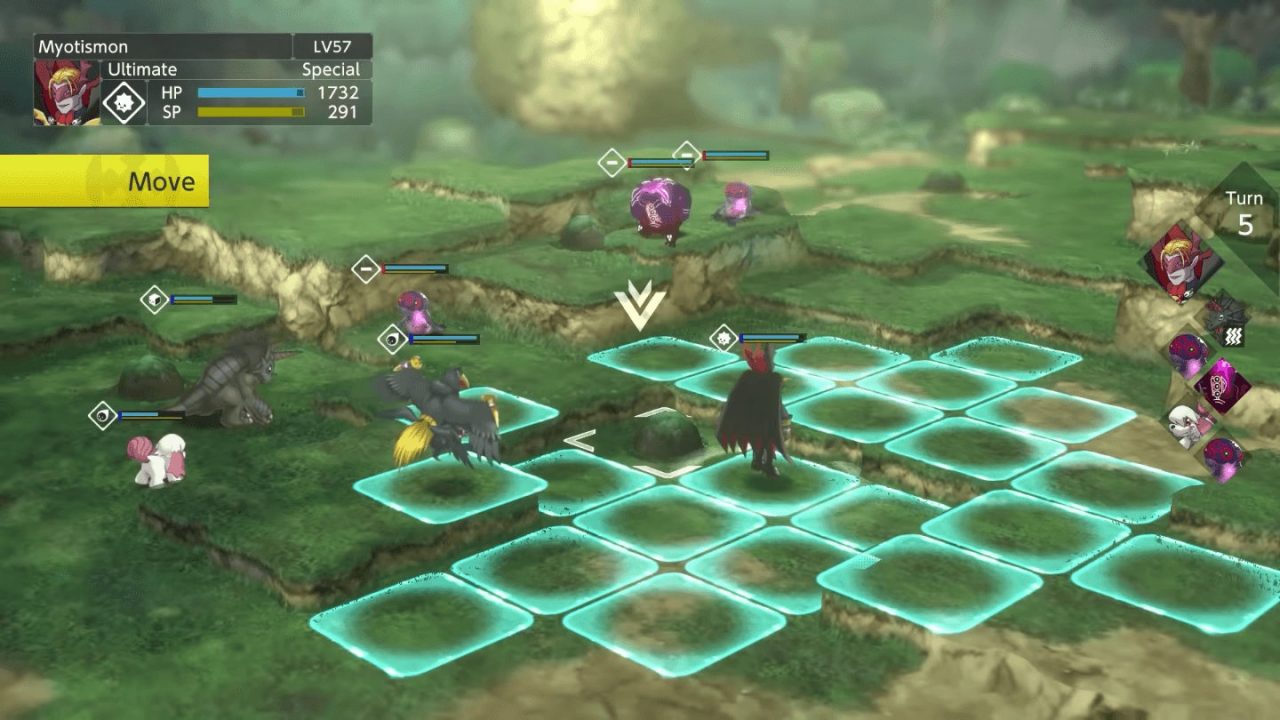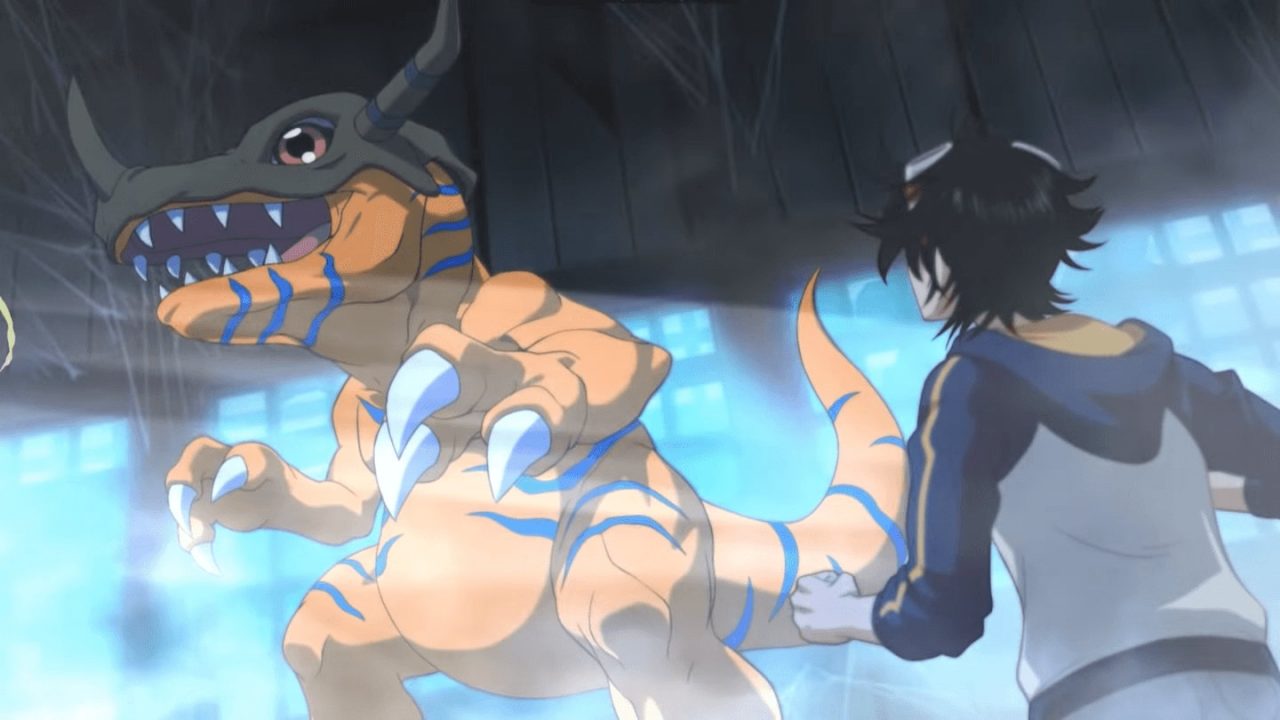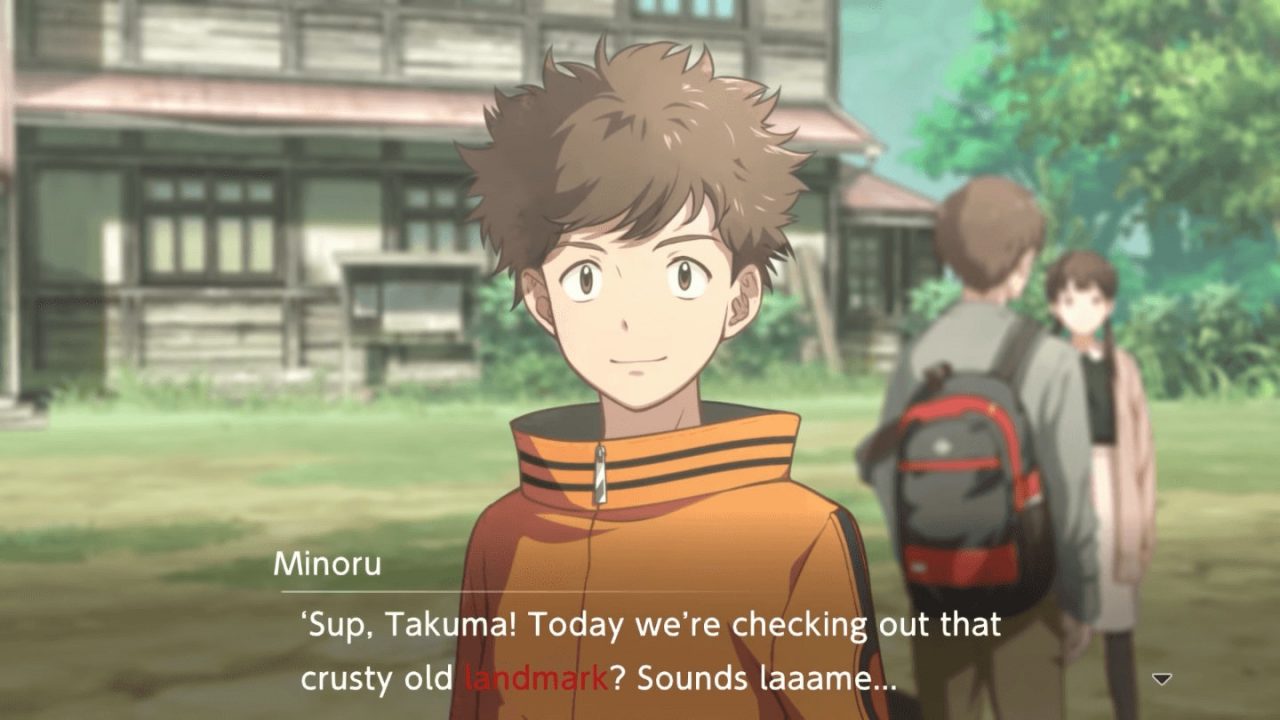The visual novel format lends itself incredibly well to flexibility. Digimon Survive seeks to capitalize on this flexibility by interspersing grid-based SRPG battles between visual novel segments. Although the implementation appears seamless, the tragically beautiful Digimon Survive is at odds with itself, not particularly excelling in either of its halves.
Of its two gameplay styles, most of Digimon Survive presents as a visual novel, with particular mastery over its visuals. Soft, expressive character art inhabits diligently detailed environments. They’re cohesively brought to life with gorgeous lighting, from bright days to nostalgic sunsets. Even the dead of night and dim indoor settings are a treat, as scenes never sacrifice contrast. Any given moment of Digimon Survive‘s visual novel segments looks like a high-budget anime-styled movie.
Visuals during the SRPG portions of the game don’t live up to the same standard, however. The chibi sprites representing the Digimon don’t have the same charm as their detailed visual novel counterparts. The backgrounds lack contrast, too. Details blend rather than stand out, adding confusion when navigating the battle maps. The gameplay during these maps isn’t much to write home about, either. Battles are much more akin to hikes than skirmishes, as battlefields are generally enormous, while the Digimon can move only two to four squares before buffs. Once the Digimon get close enough to their opponents to start fighting, gameplay becomes standard fare for an SRPG. Digimon move, attack, use items and defend if they don’t attack, with a rock-paper-scissors type system for some surface-level strategy that generally gets overridden by level differences. The gameplay tries to be unique in specific mechanics that attempt to correlate to the story at hand.
One such mechanic is the “Talk Command,” a personal skill that the human characters can use once per battle to buff any of the ally Digimon. But as the name implies, using a Talk Command requires the ability to talk to partner Digimon first. Characters like Shuuji and Ryo can’t unlock their Talk Commands until meeting certain conditions—conditions that aren’t possible on an initial playthrough. While Talk Command and its limitations are understandable from a narrative perspective, other mechanics that attempt to feed the SRPG gameplay and visual novel segments into each other don’t always work. This is especially true of the stats players raise during story segments.

Certain decisions made during the story will alter the protagonist Takuma’s Karma, changing his actions in the moment but not the outcome. Karma takes a long, long time to pay off—nine chapters, in fact—since it determines the “route split” players progress onto. The three routes—Harmony, Moral, and Wrathful—directly correlate to their appropriate Karma stat. During the route split, each comprising only four chapters, different story elements begin, and it’s here where different characters are at risk of outright dying. While Karma is confusing as to when it pays off, there’s another stat that is instead painfully counterintuitive: Affinity.
Narratively, Affinity represents Takuma’s closeness to each character. Throughout the game, players can speak with the other cast members, and their Affinity may increase depending on the dialogue choices. It’s important to note that these choices are specifically for Takuma speaking to the human character, not their Digimon. But mechanically, Affinity has no bearing on whether a character survives the game or not. It’s very awkward to have characters with very high or nearly maxed-out Affinity up and die simply because of the route they’re on. Instead, Affinity determines when a person’s partner Digimon can evolve into its next stage.
Most characters’ Digimon first evolves into the Champion level at specific points in the story to correlate to their character growth. Digimon are highly attuned to their partner’s state of mind, making these scenes of the humans overcoming their weaknesses feel very special when culminating in their Digimon’s evolution. But after this, players must get 30 Affinity with the human characters for their Digimon to evolve into their Ultimate level form. These evolution scenarios take place in a generic forest map so detached from the rest of the story that the location doesn’t even appear until a Digimon can evolve. During these minuscule levels, the human and Digimon exchange a few lines of dialogue that would have players believe that the character has undergone some growth, but it’s never reflected in the story.

Because of how the Champion-level evolution scenes play out, the intent is clearly for evolution to occur when a person’s mind is heightened and their bond with their Digimon strengthens. It’s also clear that Takuma’s relation to the characters has nothing to do with evolution because Takuma stays hidden from view for the entirety of each evolution scene. But that makes the use of Affinity for evolution all the stranger since the stat relates to Takuma’s bond with the human, not the human’s bond with their Digimon.
Many moments throughout Digimon Survive would have served as great points for unlocking evolutions, such as Minoru and Falcomon agreeing to trust one another after an enormous spat, which occurs after Falcomon’s Champion evolution unlocks. Instead, Affinity only serves to gate evolutions, which can be very frustrating when combined with Karma moving the story forward onto the route split. Players who go into the game without prior knowledge of the surprises awaiting them may find their best characters dying because of the route they went on unknowingly, even high-level Digimon with high Affinity. These factors already make it difficult to grow attached to the cast: when it’s possible that anyone can die and players can do nothing to save them, why bother? It makes the discrepancy between evolution during battle versus during the story stand out.
Digimon rarely evolve as part of the story, and it makes sense why: most evolutions are optional, thanks to Affinity. Evolution does serve a purpose during Digimon Surive’s SRPG battles. However, evolution comes with a fantastic increase in stats and, perhaps more importantly, movement increases and movement type changes. There is no reason to use Falcomon or its Champion evolution Diatrymon when the Ultimate stage Crowmon can fly instead of walk. During battle, partner Digimon can evolve into later stages and even devolve to prior stages at the player’s command, and it’s certainly a fascinating idea. But in practicality, it serves no purpose when evolved forms are always just better than their pre-evolved counterparts. Aoi’s Labramon is an especially notable example: Labramon has access to a healing skill, Cure Liqueur, that its offensive evolutions, Dobermon and Cerberusmon, don’t. Using this character would be an excellent opportunity to take advantage of evolving and devolving as needed. But since its evolutions are better stat-wise, in the end, it’s better to evolve as high as possible and use healing items as needed, especially since they’re all long-range.

It feels like partner Digimon can evolve forward and backward during battle mainly to justify them always being at Rookie-level in the story—precisely since most of the evolutions are optional—rather than for any meaningful gameplay purpose. It makes Affinity feel even more useless as a stat, although players certainly want to prioritize it for the evolution benefits. Ultimately, the gameplay and story don’t mesh, leaving Digimon Survive with an SRPG system that’s simply alright and doesn’t particularly enhance its storytelling.
Even by itself, the game’s story doesn’t shine as much as its gorgeous graphics do. The cast members who aren’t Takuma have a lot of heart, with unique struggles that get explored on the different routes. But getting to those points can be a test of patience, as much of the story involves the characters waiting for things to happen rather than actively going out due to fear. The lore of an alternate world filled with Digimon connected to our world is innately fascinating but takes a backseat to the individual characters’ struggles. The character focus should be a good thing, but the overall passiveness of the cast severely hampers it. Specific characters making bold, active decisions near the ends of specific routes are a breath of fresh air and enjoyable. However, the journey to get to those points can feel as sluggish as the beginning of one of Digimon Survive’s battles across its massive battlefield.
Digimon Survive should have a lot of depth, with partner Digimon evolving and devolving, free-roaming Digimon to recruit, and a vibrant cast of characters who, on the surface, are generally enjoyable. Looking at the game from afar, it truly captures a feeling of desolation and nostalgia. But it comes up just short when it comes to gameplay and story—the two most important things for an SRPG and visual novel hybrid. A “Truthful” path awaits as a New Game+ option, but the gameplay shortcomings, unfortunately, aren’t alleviated with repeat playthroughs. Digimon Survive‘s charms aren’t fleeting by any means, but neither are its disappointments.


